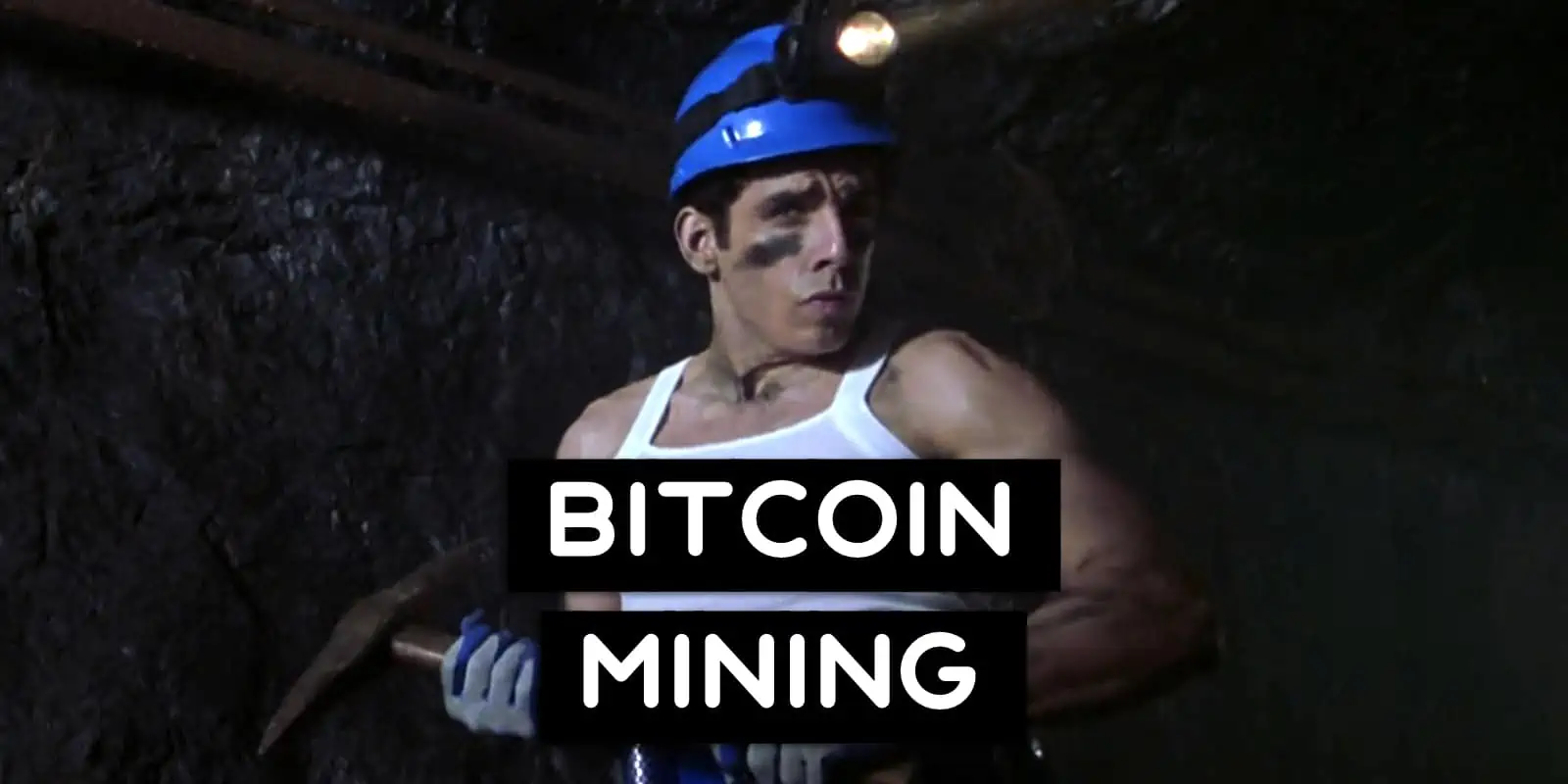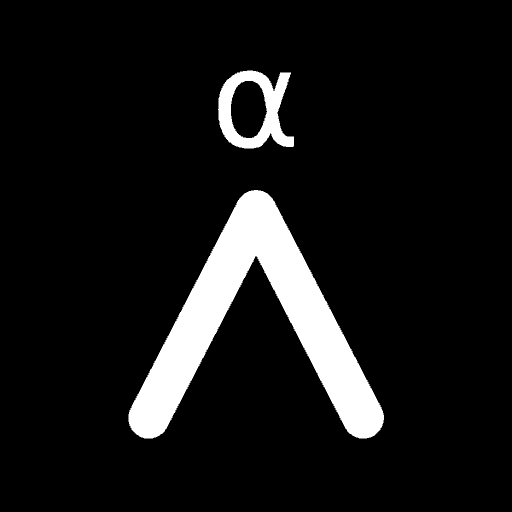Welcome fren! Bitcoin mining started when Satoshi mined the very first block in the blockchain, the genesis block, way back in 2009. But what is Bitcoin mining? Can you just dl an app and get some sweet bitcoins? No. That’s totally not how it works. But! In this massive guide we break everything down simply and answer every question that’s currently confusing you. LFG 🚀
Contents
What Is Bitcoin Mining?
Mining is the process of adding transactions to the Bitcoin Blockchain.
Proof-of-Work (PoW) mining also performs two other critical functions in the Bitcoin network:
- Secures the network from attackers
- Issues / mints new bitcoins in a fair, automatic and distributed way
While many think the idea of having a digital currency was the “breakthrough”, it’s arguably more the PoW, mining and difficulty adjustment ideas that combined to be the true utter genius invention.
Before Bitcoin there were a slew of digital, cryptographic based currency attempts that all failed. It wasn’t until the mining process, PoW and the difficulty adjustment mechanism was fully fleshed out and laid bare by Satoshi that the digital cryptocurrency industry was truly born.
Before we go super deep into how Bitcoin mining works though, let’s quickly recap a couple of basic things, specifically what Bitcoin is and what the blockchain is.
What Is Bitcoin?
So what exactly is Bitcoin? Bitcoin is the first and most globally recognized cryptocurrency. It is a free, fully open source, decentralized and entirely digital currency for all.
OK explain Bitcoin to me like I’m 5: Bitcoin is online money that enables instant payments. Free for anyone, anywhere in the world to use at any time. It uses peer-to-peer technology (like torrents) and can be used without any permission from a government or central authority. It cannot be stopped or censored. Its rules cannot be changed, no matter how rich or powerful a country or person is.
Created by cryptographers (Cypherpunks technically) to cure the money problems caused by big governments and big banks it joins their other world changing technologies such as encryption of the Internet, encrypted messaging and the Tor project.
Some basic properties of Bitcoin:
- Limited Supply: There will only ever be 21 million bitcoins
- Distributed: All transactions are stored on thousands of computers all across the world
- Always Open: Unlike legacy banks, you can buy, sell, send or receive it globally, 24/7/365
- Transparent: The Bitcoin blockchain is public and viewable to anyone world wide
- Peer-To-Peer: No banks are involved, transactions go from one person to the other
- Permissionless: It can be used without having to ask anyone for permission
- Censorship Resistant: You’d have to stop the Internet to stop it
- Easily Divisible: 1 BTC can be divided into 100 million pieces called “Satoshi”
- Protected: The worlds biggest supercomputer made up of miners protect every bitcoin
- Final Settlement: Bitcoin transactions, once confirmed in a block are irreversible
- Pseudo-Anonymous: There are no names or accounts. It should be noted that it’s still possible to link Bitcoin Addresses to real life names if care is not taken to protect your Bitcoin Privacy
For a more in depth look into Bitcoin you can check our our piece What Is A Bitcoin? If you’d prefer a shorter explanation though try How Does Bitcoin Work For Dummies?
What Is The Blockchain?
Just like any type of money, Bitcoin needs a way of keeping track of who owns what bitcoins. This is referred to as a ledger and is essentially just a big database / book that is constantly updated to show who owns what. For example it might say “Bill owns 1 bitcoin”.
Obviously, having access to this ledger would mean having full control over all the value of the network. You could update it to say anyone owns any amount of bitcoins! Traditionally, this power was given to governments or kings… who would then abuse it. As they say, absolute power corrupts absolutely.
Instead, Bitcoin uses a new technology called a blockchain or distributed ledger technology to completely take humans out of the equation. This ensures there is no abuse of this power ever again.
When a transaction is broadcast and ownership of various bitcoins change hands, it’s bundled together into a “block”. This block is then added or “chained” onto all the existing ones. All these individual blocks, chained together form the blockchain which is stored on all Bitcoin Full Nodes.
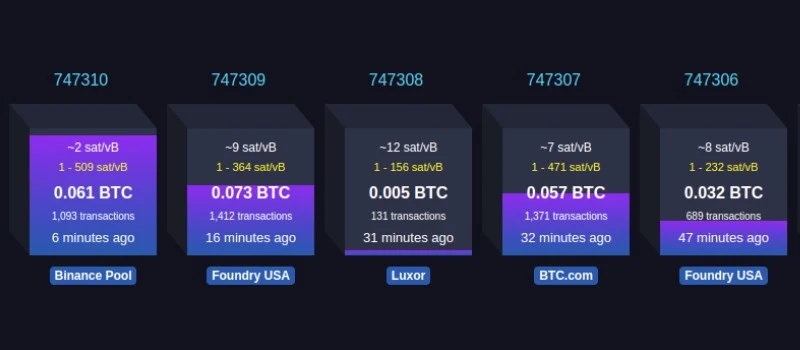
A great way to visualize the blockchain and this process is to look at mempool.space as shown above. You can see each block – live! – as transactions from all over the world are added to it and then sealed forever into the ever growing Bitcoin blockchain. For example in the picture above, block 747310 has 1,093 transactions sealed in it.
The blockchain is Immutable – meaning it can never be altered – and transparent. This means anyone, anywhere and at anytime can see any transaction that has ever happened on the Bitcoin network.
How Does Bitcoin Mining Work?
OK. Now that we’ve covered those basic things you should be in a much better position to understand the fully in depth explanation on how Bitcoin mining works. Let’s go!
In our Bitcoin network we have many nodes. Each node is capable of mining and contains both the mempool (shown with green transactions) as well as a full copy of the Bitcoin blockchain (with the blue blocks). The Mempool is just all the most recent transactions that haven’t yet been confirmed into the blockchain.
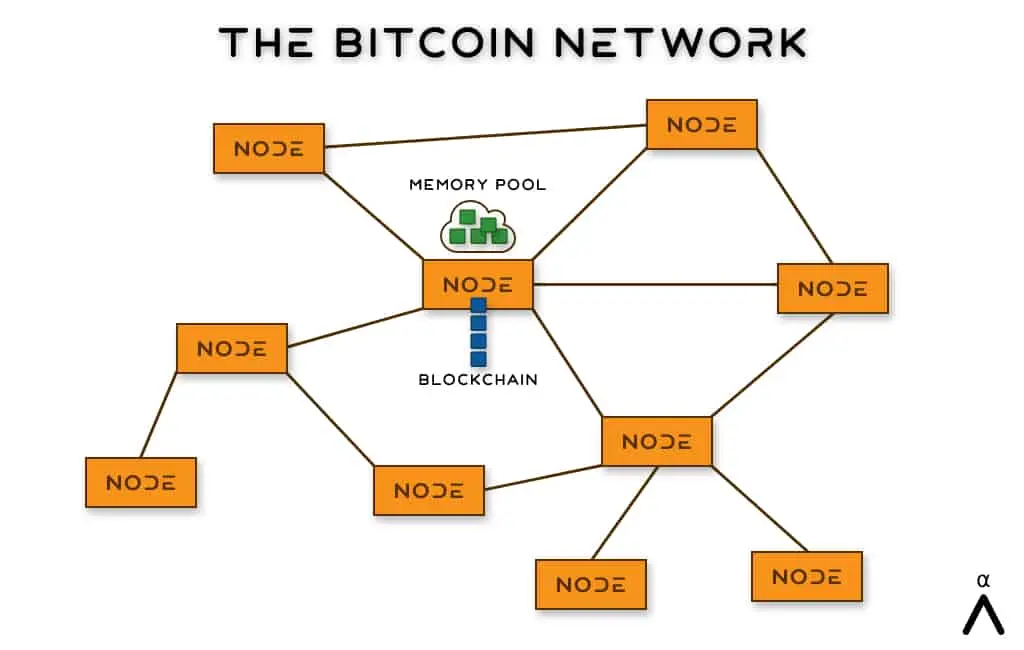
Mining takes those transactions in the mempool, bundles them together and confirms them into the blockchain.
To perform this mining process though, a miner needs to expend a lot of computer processing power or “work”. This work takes the form of a challenge.
The first step of this challenge is to take all the transactions in your memory pool and hash them. This gives you a big long random string like so.
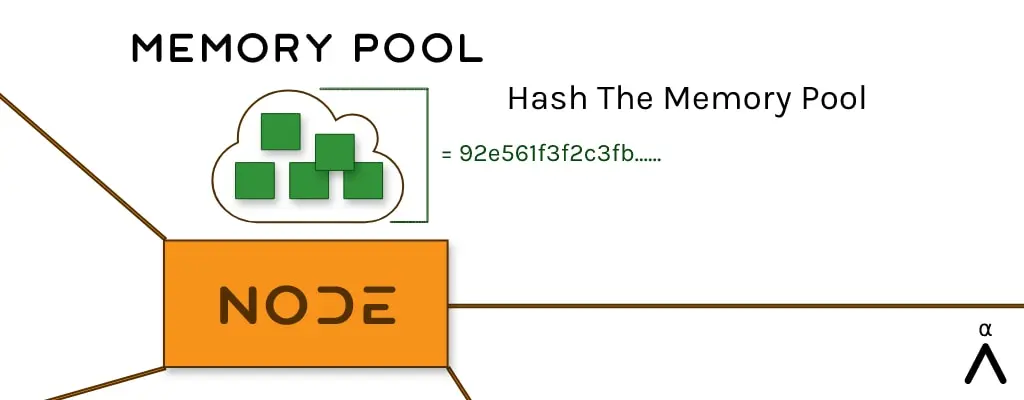
Now to win the challenge, you have to hash that string with another random number of your choosing (called a nonce) and try to get a new string that begins with a bunch of zeros.
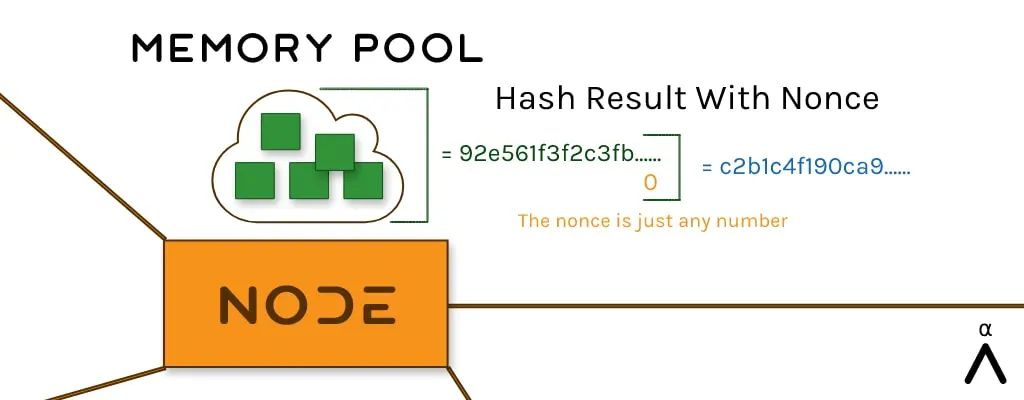
This is extremely difficult to do as the hashing process is essentially random. The only way you can win the challenge is through sheer brute force. Performing this same hashing process (Step 2) over and over and over again until…
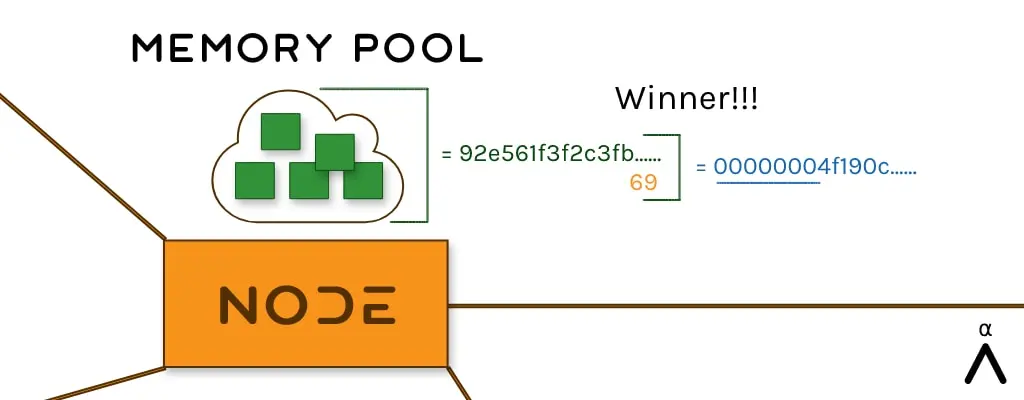
You win! Eventually with enough time and enough hashes, you’ll stumble onto a nonce that, together with the original string, hashes together to give you a result that has a bunch of zeros at the front. The number of zeros is determined by the adjustment difficulty factor (explained below).
At this point you have “solved” the block and all of the transactions inside are added onto the blockchain. You also broadcast this new block to every other node on the network which adds it to their blockchain assuming everything checks out and is valid.
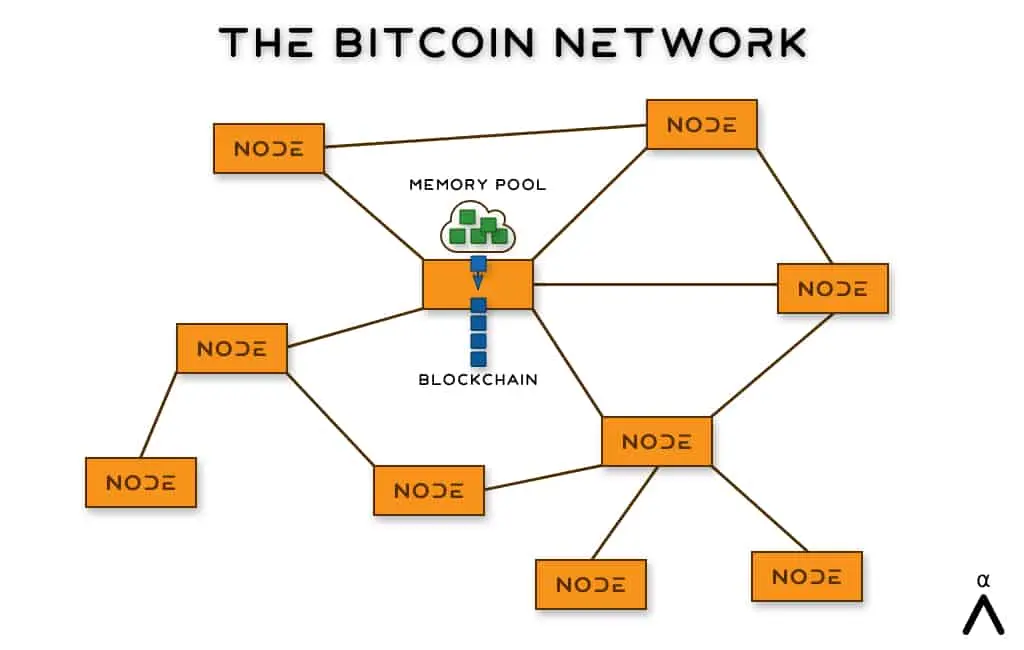
If you’re the first miner to win this challenge and broadcast your valid block to every other node you not only get to keep all the fees paid by all the transactions in that block, but a generous 3.125 BTC (the block reward) on top of that too! Yes, step 3 really is profit this time!
What Is Proof Of Work (PoW)?
Proof of Work or PoW was originally created to stop bad actors from overwhelming a system. As the name suggests, you perform some work (such as completing a small challenge as outlined above) and then provide the results of this work as proof that your interaction is legitimate.
One of the best examples of this is to stop bad actors from sending out millions of emails without any consequences. With PoW, they would have to expend a small amount of effort for each email they sent, making the spamming process basically impossible.
While many people assume that PoW debuted with Bitcoin or was invented by Satoshi Nakamoto, this is not true. While Satoshi improved on it, the Proof of Work (PoW) mechanism that Bitcoin uses was related to the one in Hashcash, which was introduced and published by Adam Back in 1997. Satoshi makes explicit reference to this in the Bitcoin Whitepaper under reference number 6.
Adam also personally reviewed our dedicated piece on PoW for accuracy and correctness too which you can read below!
PoW is also unique in that it can be verified and trusted simply by looking at it. You don’t need to trust a third party to know that the blockchain is legitimate, the proof is right there. Just like you can look at Arnold Schwarzenegger and know (without trusting any third party) that he put in the work to get that jacked, so too can you look at the blockchain and know that it’s legit.
What Is Mining Difficulty?
Satoshi knew that technology – especially computers! – are constantly getting better and better over time. Given the current pace that computers are evolving it’s estimated that by 2030 laptops will be as powerful as some super computers are now. Because of this, they had to design the mining challenge process to adapt and adjust to this ever growing capability of compute power.
The mining difficulty adjustment measures how difficult it is to find a new block compared to the easiest it can ever be. After every 2,016 blocks it’s automatically recalculated to make sure that the previous 2,016 blocks would have been mined in exactly two weeks (1 block every 10 minutes = 6 blocks x 24 hours x 14 days = 2,016).
This difficulty adjustment calculation ensures that, on average, the Bitcoin network will mine blocks at an average rate of one block every ten minutes no matter how many miners join or how much faster computers get.
As the mining of blocks also results in the distribution of new bitcoins via the block rewards (see bitcoin distribution section below), this simple but brilliant difficulty adjustment mechanism also ensures that the monetary policy that issues new coins remains stable even over the course of decades of technology advancement.
What Do Bitcoin Miners Do?
As mentioned before, miners don’t just add new transactions to the blockchain. The process also ensures that the entire network is kept safe as well as enables the fair and even distribution of new coins (see next section).
The block reward of 3.125 BTC (plus all those transaction fees) is worth hundreds of thousands of dollars. This has created a huge worldwide competition to get this reward as it’s open to anyone, anywhere. The more miners there are, the more “hashing power” or Hash Rate the Bitcoin network has. The more hashrate the network has, the harder the difficulty factor ramps up to compensate for the added competition.
Currently, Bitcoins hashrate is around 600 EH/s (ExaHash per second). This means that each second, miners collectively around the world perform 600 ExaHashs (600,000,000,000,000,000,000) to try and solve this ongoing block challenge.
This huge, globally decentralized super network of computers ensures that adding new blocks is incredibly difficult. If you wanted to insert fraudulent transactions into the network, you’d have to out compete all of this combined power so that your mining computer solves the block first and thus, gets to insert your fraudulent transactions.
This is possible to do… but you’ll need a few billion dollars worth of computing infrastructure and at that point, you may as well just use it to mine bitcoins normally as you’ll get all the block rewards!
As the number of miners increase, this high bar keeps getting more and more difficult. Anyone wanting to hack or get around it is always met with the same impenetrable wall made up of the worlds largest and most powerful supercomputer network.
How Is Bitcoin Distributed?
With no central authority, Bitcoin somehow needs a way to mint and distribute the 21 million bitcoins. To do this, Satoshi decided that in order to receive these newly minted bitcoins a person had to prove that they have fairly worked for them.
This work, as explained above, had to use a real world, physically limiting thing as otherwise they could just copy/paste the work a billion times and be rich with zero effort. PoW and the mining process is what provides this “proof” to the network and as a result, miners that solve a block get both the block reward and all the fees in each of the transactions that they’ve mined.
An important distinction should also be noted at this time. Miners do not “create” new bitcoins. They create or produce new blocks. If this new block meets the rules of the Bitcoin network and is accepted and validated by all the other nodes on the network, then they will be rewarded with the block reward.
The block reward is currently 3.125 BTC. Originally it used to be 50 BTC but over the years it has been cut in half a number of times in what’s called the “Bitcoin Halving” or halvening. This lets the network mint and distribute new bitcoins while giving a higher reward to those that adopt the network (and do mining) first. A very fair process!
Dive Deeper: Bitcoin Halving
These happens every 210,000 blocks which is roughly around every 4 years. Since the genesis block there have been 4 halvings (28th Nov 2012, 9th Jul 2016, 11th May 2020 and 20th April, 2024) and when the next one occurs in 2028, this 3.125 BTC block reward will be halved once again down to 1.5625 BTC further slowing the issuance of new bitcoins.
Written into the core of the Bitcoin software is a hard coded limit of 21 million bitcoins. This means that even in a million years time, there will still only ever be 21 million coins. Given the predictable issuance of new coins and the reduction of block rewards, all 21 million of them will be mined by 2140.
Another important point to note is that increasing the amount of computing power dedicated to mining bitcoin doesn’t mean more bitcoins will be mined. If you add more miners with more computing power it just increases their chance of being rewarded in the next block.
How To Start Bitcoin Mining
As more and more miners have entered the Bitcoin network over the years the difficulty rate has increased. While you could easily mine bitcoins on your home laptop years ago, now it’s really only possible since 2013 using custom designed pieces of hardware called application-specific integrated circuit or ASICs.
These take the form of dedicated pieces of mining hardware that get packed into anything from single boxes in peoples homes, all the way up to thousands of units in a data center.
Unfortunately this means that mining now requires you to have a few pretty decent resources in order to do it. To start with you’ll need the ASIC mining hardware which can cost up to $10,000 USD brand new. You can also buy cheaper, second hand ones or ones that aren’t as powerful too.
For example, to get started with just one top of the line ASIC you’d need:
- ASIC mining hardware, say the ANTMINER S19 XP which does 140 Th/s
- A 15+ Amp socket @ 240 V to power it (or a 30+ Amp socket @ 120 V)
- Ability to pay the power bills as it uses 72 kWh per day!
- Ability to cool it or somehow vent out all the heat it generates
- A place to put it, as it’s very, very loud due to the high powered fans
Once you’ve bought and setup your mining hardware, you simply join a mining pool and let it run! It will automatically join the mining pool and start hashing day and night to try and solve that challenge. If any of the miners in your pool solve it, you all share the block reward based on how much hashrate you’ve committed to the network.
When choosing which mining pool to join, it’s important to make sure you know how they will pay out the rewards, what fees they charge and just generally see what people say about them.
How Much Can You Make Mining Bitcoin?
Mining of bitcoins has grown into a multi hundred billion dollar industry. That being said, it can still absolutely be done with just 1 ASIC miner at home, how much you “make” depends on a few factors:
- The cost of the ASICs you buy, including upkeep and maintenance
- The hashing power of the ASICs
- The cost of the electricity you use
- The difficult rate of the Bitcoin network
- The exchange rate of Bitcoin to your local currency
- The fees your mining pool takes
A good way to calculate profitability for your own personal situation is to check out WhatToMine.com. This site takes into consideration the current price of bitcoin along with different ASIC miners, electricity rates and more.
How To Mine Bitcoin At Home
The actual act of mining bitcoin at home is not particularly hard. Just like most other computers, the bitcoin mining ASIC will need somewhere to sit, power and some software configuration to set it up along with occasional cleaning. The “mining” part is all done by the hardware and is basically automatic.
That being said, you will need access to a high amperage power point. Some miners use upwards of 3,000 Watts (15+ A @ 240 V or 30+ A @ 120 V). This power point will also need to be somewhere out of the way as mining hardware makes a lot of noise due to the fans used to cool them.
On top of all this you’ll need to consider cooling as they produce a considerable amount of heat too. All this combines with the high initial purchase price of the mining hardware and the ongoing high power consumption costs to make mining at home only possible for some. This is a shame as mining your own bitcoins is a great way to improve your Bitcoin Privacy.
What Are Bitcoin Mining Pools?
Mining pools are groups of miners that have all come together to “pool” their hashing power and thus, increase the likelihood that they will win the mining challenge more often. In return, if any one of the miners successfully solves a block, they agree to share the block reward with everyone else equal to how much hash power they contributed. Most mining pool services also charge a small fee.
While you don’t have to join a mining pool to mine bitcoin, the chances of an individual mining a block all on their own is astonishingly slim. Even with a top of the line ASIC miner running at 140 Th/s, it would take around 25+ years just to mine one block.
What Are Bitcoin Mining Farms?
Bitcoin mining farms are basically the “data centers” of the mining world. While you might only have 1 ASIC mining away at home, big businesses can have thousands of them all crammed into a warehouse or even custom built data centers that are called farms. They are often specifically located next to things that need lots of heat or have cheap or excess power.
What is Bitcoin Cloud Mining?
Mining in the cloud allows users to purchase mining capacity in data centers that mine on their behalf. The cloud mining company manages all the hardware, software, upkeep, power and technical issues, while you provide some investment.
While this can sound like a win/win, the downsides are that it leads to lower profits, there is the high chance of fraud and you are often confined by contracts.
Is Bitcoin Mining Legal?
Bitcoin mining is legal in most countries around the world but unfortunately not all. Obviously this is an ongoing and quickly changing thing, so the below list may be out of date, but currently Bitcoin mining is illegal in:
- Algeria
- Bangladesh
- Bolivia
- China
- Egypt
- Kosovo
- Morocco
- Nepal
For more detailed and up to date information please see Wikipedia.
Taxes On Bitcoin Mining
Just like with any other income generating activity, bitcoin mining is taxable in most countries. Depending on the country and how you’re setup, you may be eligible to deduct the costs of the mining hardware, pool fees, electricity and more as expenses.
As you receive the bitcoin income it’s important to keep accurate and complete records and to report it as such to your tax authority. You should always check with a certified tax account to ensure you’re following all required tax laws and maximizing your profits.
Risks Of Bitcoin Mining
- Price Volatility: One of the biggest risk when mining bitcoin is the exchange rate of it to your local currency. Bitcoin has gone through multiple huge bull and bear markets. This extreme volatility can make it difficult to know if all the money (both up front and ongoing) will be paid back if another major price crash comes around.
- Regulation: While many countries view Bitcoin as a positive thing, many don’t and regulation can often change quickly. Given how new and miss understood Bitcoin is, regulation changes are a decent risk to miners as they could severely reduce profits or even outright ban it with the stroke of a pen.
- Hardware Damage: Many bitcoin mining hardware uses high power and outputs a lot of heat. If these are not managed well there is the potential for damage to the expensive mining hardware or even other electronics or your house. Always ensure you have a qualified electrician look over your setup and properly maintain your equipment.
- Reduction In Block Reward: Every 210,000 blocks or around 4 years the block reward halves. This means that your income (in bitcoin amounts) will halve. While this is an absolutely known risk, it still needs to be taken into your calculations. The next Bitcoin Halving will be in 2028.
- Can Be Illegal: As outlined above, a few countries outright ban bitcoin mining making it quite risky to do it in them.
Is Bitcoin Mining Bad For The Environment?
Like many Bitcoin Myths, there are many versions of this concern, mainly revolving around Bitcoin mining using up too much energy and causing too much pollution. While many of these hit pieces are factually incorrect or even totally misunderstand how Bitcoin works at a fundamental level all these arguments are moot.
Bitcoin uses energy, yes. Planes also use energy, a lot more energy and also pollute far more given the aviation industries size and where they deposit that pollution. So why are these same people not demanding we shut down all airports? The reason is obvious, it’s because millions of people – especially the rich – find flying very, very useful!
So, when various sources question Bitcoin’s energy usage what they’re really saying is “this energy use isn’t useful to me, so it should be stopped”.
These people need to check their financial privilege!
These people, often politicians or members of world legacy financial institutions like the IMF sit pretty in their first world countries with their fully developed and (mostly) stable financial systems. They have a bank account. Can get a loan anytime the want. Can earn $100 and have it still be worth pretty close to $100 the next year. However this is the exception, not the rule for the world.
87% of our planet’s population are born into autocracy or untrustworthy currencies. 4.3 billion people live under authoritarianism, and 1.2 billion people live under double- or triple-digit inflation.
For the other 4+ billion people in our world Bitcoin is a shining beacon of hope that for many gives them their first actual bank account ever. Just imagine if you had no bank account at all. Think how that would limit your life. Think of all the things you wouldn’t be able to do. And these people have the nerve to infer that Bitcoin’s energy consumption isn’t “useful”.
Bitcoin Mining absolutely uses energy, would we prefer it to be 100% renewable energy? Of course. Although it’s already further towards this goal than the vast majority of other industries on Earth, including America and the legacy financial system!
But just like planes and food production that all uses far more energy, Bitcoin provides a core, vital service for literally billions of people all around the planet that have never had free, open source money that they can use without it being debased or banned or seized by their government.
It stops peoples life savings being inflated away in Nigeria. It allows remittance for free and in seconds for millions in El Salvador. It helps refugees of Ukraine flee their war torn country without being robbed of all their money on the way.
Furthermore, if you’re an advocate for Bitcoin such as we are, we’d like to encourage you to partner with and support Climate Change Activists rather than fight against them. They’re often fighting for very similar goals as we outline in detail in our piece Bitcoiners Should Love Climate Change Activists.
So yes, unfortunately Bitcoin Mining does use a lot of energy and causes pollution. But the answer isn’t to ban it, the answer is to end fossil fuels because once that’s done, Bitcoin will be 100% renewable and still continue to provide critical, basic financial services to everyone on the planet.
If you’d like more in depth information on this, look no further than the fantastic Nik Carter.
FAQ
What Is A Bitcoin Miner?
Technically a bitcoin miner is any computer that runs the mining feature of the Bitcoin Core software. This mining software is responsible for adding transactions to the Bitcoin blockchain.
As more and more miners have entered the Bitcoin network over the years the difficulty rate has increased. While you could easily mine bitcoins on your home laptop years ago, now it’s really only possible since 2013 using custom designed pieces of hardware called application-specific integrated circuit or ASICs.
These take the form of dedicated pieces of mining hardware (for example the Antminer S19 XP) that get packed into anything from single boxes in peoples homes, all the way up to thousands of units in a data center.
Is Bitcoin Mining Profitable?
A good way to calculate profitability for your own personal situation is to check out WhatToMine.com. This site takes into consideration the current price of bitcoin along with different ASIC miners, electricity rates and more.
What Is A Good Hashrate For Bitcoin Mining?
Hash Rate is a unit of measurement that tells you how many SHA-256 hashes the computer (or miner) can calculate per second. The higher the value, the more hashes and the more likely your miner is to “win” the mining challenge and get the reward. High end bitcoin miners can do around 100+ Th/s (Terahashes or 100,000,000,000 hashes per second).
How Much Bandwidth Does Bitcoin Mining Use?
While mining of bitcoin doesn’t take up a lot of data, as the hashing challenge is done locally on the miner, it’s good to have a fast and reliable “broadband” internet connection. This should have an upload speed of at least 0.5 Mbps.
How Many Bitcoins Have Been Mined?
Over 19,600,000 bitcoins have already been mined. For the most up to date figure check out our How Many Bitcoins Are There page that gives real time, detailed amounts on the Bitcoin supply.
When Will All Bitcoin Be Mined?
While there is no specific date, best estimates suggest the last bitcoin will be mined somewhere around 2130 to 2140.
How Long Does It Take To Mine 1 Bitcoin?
At the current rate of issuance, 1 bitcoin is mined every 192 seconds on average. This is because the block reward is currently 3.125 BTC per block and a new block is mined on average every 10 minutes.
10 minutes / 3.125 blocks = 192 seconds
What’s The Best Bitcoin Mining App For Android?
Mining cannot be done on any phone (iPhone or Android) as they cannot perform the hashing task that is core to bitcoin mining fast enough. While you could easily mine bitcoins on your home laptop years ago, now it’s really only possible since 2013 using custom designed pieces of hardware called application-specific integrated circuit or ASICs.
These take the form of dedicated pieces of mining hardware (for example the Antminer S19 XP) that get packed into anything from single boxes in peoples homes, all the way up to thousands of units in a data center.
Why Does Bitcoin Need To Be Mined?
The mining process performs three main functions:
– Adds new transactions to the Bitcoin blockchain
– Secures the network from attackers
– Issues / mints new bitcoins in a fair, automatic and distributed way
If mining didn’t mint new bitcoins then there wouldn’t be any bitcoins at all. At some point in the future, around 2130-2140 the mining process will stop issuing new bitcoins. Mining will still be required as it has to still provide the other two functions above.
What Does Mining Bitcoin Mean?
Mining is the process of adding transactions to the Bitcoin blockchain.
How Hard Is It To Mine Bitcoin?
Currently, Bitcoins hashrate is around 600 EH/s (ExaHash per second). This means that each second, miners collectively around the world perform 600 ExaHashs (600,000,000,000,000,000,000) to try and solve the mining challenge.
This huge, globally decentralized super network of computers ensures that adding new blocks is incredibly difficult. With the correct mining hardware and joining a mining pool it’s still possible to profitably mine bitcoins provided you have the required capital and low electricity rate.

